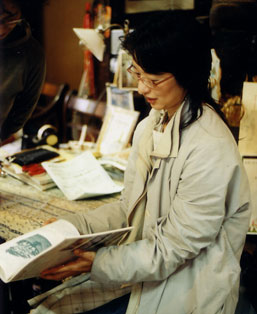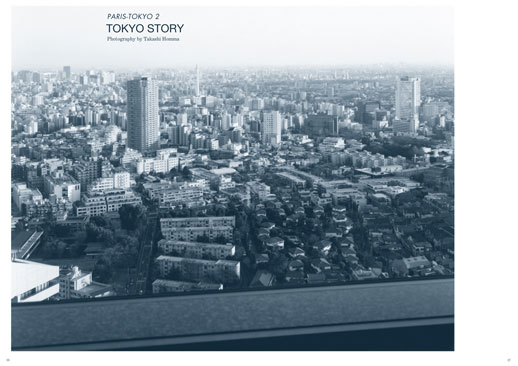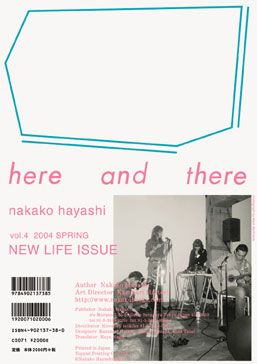Here and There: An Intimate Journal

Since 2002 Nakako has mothered her independent magazine Here and There, later becoming a mother to her own baby boy in 2004. Calling her the ‘mother’ of Here and There is not intended to be saccharine or sentimental: the magazine is a genuinely personal creation, co art-directed with and designed by her long-time friend Kazunari Hattori. It is produced as a record of her time, her friends and the events around her that she felt were too important to be left undocumented.
TAB interviewed Nakako at Hiromi-sans’ flower shop in the graying backstreets of Nezu. It was a standard, even archetypal, Japanese flower shop with a shambolic green mountain of pot plants and flowers outside a half-opened wooden door. This is one of Nakako’s favorite areas in Tokyo. In person Nakako is softly spoken, with a slight French accent.
So Nakako, where does Here and There come from? What made you want to start an independent magazine like this?
Well, when I started working with Hanatsubaki magazine in the late eighties, I could try and see what was most exciting right then, without really worrying about a commercial kind of view. You could really have a creative feel. We only had to have two pages for the Shiseido products, and we could edit freely without any influence on the other content. It was a very free place; we didn’t really have limitations from advertising. My editor in chief was really interested in fashion, specifically London fashion and Paris fashion, so as an assistant to her I started going to Paris fashion week, really only as an assistant, but I continued repeating this every March and October since 1992.
I took all the photos and video to go with the articles. But then this article would go away after only one month and I would have done so much work to realize only 6 pages… so much work! So I wanted to keep it as material for a book and sell it in a bookshop. This was before Here and There. So I made a book called Paris Collection Individuals, looking at young designers, and Little More published it. I made it once in 1999 and again in 2000, two times.
After trying the book with Little More I found it more exciting to do on my own thing, because the way I like the way I design – my style, I feel, is closer to doing things independently. For me it’s more natural and makes sense. So in 2001 I left Hanatsubaki magazine for many reasons, and decided to freelance.
I have always liked people like Elein Fleiss, Bless, Susan Cianciolo, and more recently Yukinori Maeda; those people are kind of strong, really ‘outside’. That became a problem with other people at the magazine. But for me, these were people living right now, and their story was not written in a book yet because they are quite new and… I think that’s what the mission of Here and There was. I decided that’s what I would do: I really wanted to write a book of these people living in the same era, they are very strong and very talented and out of today’s categories, and they seem historically important to me.

When looking at Here and There and comparing it with other magazines, it really stands out graphically. How did you come to work with your art director, Kazunari Hattori, and what is the extent of his involvement in Here and There?
Well, I really worked closely with Takashi Homma in my twenties, and Kazunari Hattori was working in the same company with Takashi years ago, so they know each other so well. Takashi had seen a few books that I had already made, so he recommended to Kazunari that we had a style that would be complementary. I thought maybe Kazunari would be nice because he had no experience in the magazine field before that. He was the art director for Ryuko Tsushin for maybe two years, which came after his work with Here and There.
I think the content really comes from me. But I will show him the text and photos, and I think he really reads deeply. I know some designers will design without really looking through the content, but I think Kazunari really reads deep before he designs.
I have seen that issue where Kazunari made the cover smaller than the inside pages, as a kind of acknowledgement of the way your bag is always too small for your papers. What is it like making an independent magazine? What are your thoughts about doing something like this independently?
Firstly, I need to tell the photographers and the writers before they work for Here and There that I’m sorry, but we can’t pay money. For the first issue of Here and There all the photography and text came from me.
Maybe it’s difficult, I don’t know, because I don’t intend to make ten thousand or five thousand copies, numbers like that. I always do around one thousand, one thousand five hundred copies. I don’t really intend to make it bigger.
I think it should be very personal and passionate, if you lose the passion it’s better to do nothing. If you have no interest in creating then you should not do it; nobody is asking you to do it. If there is a contract with the publisher and then you have to promise to produce a magazine twice or four times a year and then you have to make a compromise with what you think. Because I choose to do it on my own, I can make it when I really want to make it. It comes out once a year, at the start (2002) it came out twice a year and at the time I thought I could keep that up, but it’s difficult.

So where does Here and There fit in Tokyo? What kind of a magazine would you say it is? I was recently looking for a copy in the ABC book shop in Roppongi and had a very hard time finding it. Eventually I found it on its own special stand. I guess they didn’t know where it fits either.
It’s very difficult. Of course, fashion is an important part because several people that I work with like Cosmic Wonder and Bless are fashion designers, but at the same time, there are other people I am interested in. I am most interested in those people that cannot be categorized so easily. I don’t think Here and There has a genre, but sometimes bookshop have a need to put it somewhere.
It seems as though you have been following these same people for a long time, perhaps for ten years, even while working at Hanatsubaki magazine. It seems unique for a magazine to stay so focused, not having such a hyperactive consumer approach, not constantly showing the newest and next thing.
That is my plan, to make it more like a book, that’s what I’m trying to do: it shouldn’t be changing all the time, like a standard magazine.

How does Here and There compare with other magazines? What magazines do you appreciate?
I think Japanese magazines, or at least the magazines that I work with – more like women’s fashion magazines – are not so interesting but still I see them being different from American or European magazines. Foreign fashion magazines are not so informational. I like it when the editors are really curious, really want to find something out, and I think most of the Japanese are really curious editors. I don’t know if they are more critical, but they just want to show the mood. So when I make my own magazine I don’t want to make it so informational. But I do still find that magazines are more interesting when they seek to discover.
It’s difficult: most of the time I don’t like most magazines. So there is a contradiction, because magazines that you can get the most work from are the magazines for the ‘nouveau riche’. Often they will ask me to do an art story, but its very strange because I receive the magazine and I don’t like what I see, this strange new rich lifestyle. I feel very bad after reading it. If you buy it, its expensive, and also makes you feel bad because you can’t have this lifestyle in your daily life, you can’t live like a wealthy Hong Kong mother. It’s strange to spend all this money and feel so bad after reading it.
One of the most interesting magazines I have seen recently was one I bought at my local convenience store about six months ago, which has pictures of how young people live in Tokyo, how their apartments are, showing the way they live. Most of them live in one small room, small apartment, and just decorate them according to their profession or lifestyle. If the occupant’s profession is a DJ, then he has a room with records, decorated like a DJ. Many people show their world through this decoration. Before moving to Tokyo, young high school children of about sixteen, seventeen look at the magazine and they imagine the way they want to live in Tokyo. When I traveled to Europe or America as editor of Hanatsubaki magazine I never really found many magazines of this kind. I really feel this kind of magazine is interesting.
Maybe the range of magazines in Japan has to do with the market? Maybe this type of thing can only happen in Japan, or even only in Tokyo? I have seen those kinds of ‘style guide’ magazines in convenience stores.…
I don’t really like to look at those magazines that tell you to choose this or that style but I just… I don’t know, Japanese people are curious, in a good way, to absorb influences from the rest of the world. In the early eighties and nineties there was a lot of searching from magazine editors, like RMM (a magazine from Hong Kong) is trying to do now: a search for a new culture, the most interesting things from all over the world. I think that kind of curiosity and discovery is now coming from abroad, I don’t really feel it so strongly from Tokyo culture right now. Tokyo culture is more satisfied.
Reading Here and There is a very personal experience; it feels like reading a diary.
I think the whole issue should have a diary feeling but it should be something that everyone can participate in and have room to do something. Before, I wasn’t so conscious of this kind of thing but after the ‘New Life’ issue I was doing it more deliberately. Maybe I am more conscious of what I am doing; it should have a diary aspect, but should not just be my personal diary,
I felt that if you don’t experience an exhibition or something it really means nothing to people. There was also so much news around, but always the strongest and most interesting news comes from my close friends from daily life.

What was the ‘New Life’ issue?
So, three issues ago I got pregnant and then issue four did not come out for six months after my delivery. Of course while I was pregnant, my life changed a lot, but I strongly wanted to continue Here and There as my carrier and people like Elein Fleiss and Kazunari Hattori also encouraged me to continue. It was stressful for me because my life was my baby and I was really new to this life. My concern was not open to the outside world so I wasn’t sure how I could make Here and There. For Here and There I usually had to travel a lot, because most of the inspiration came from trips to Paris and New York and the Fashion Weeks there, so I was wondering how I could do it.
I talked with friends and wondered about how it could happen because it shouldn’t all be about baby things, parenting, but still about people from the outside world.
But the world is still moving, Susan Cianciolo and Mark Borthwick came to Japan and there was something happening here (in Tokyo) and we would meet and talk. But there were not so many shows that I could see. And then one day I got an email from Susan Cianciolo with an invitation for her show at New York fashion week and the title was ‘New Life’. Then I saw that my new life is my baby, and my baby is a new life too, and since Susan had a collection of new life, which was nothing to do with baby, she was doing her own new life. So using this title I could connect my life and other artists productive activity. For the first time I could name the new issue, ‘New Life Issue’. Before, each issue was named only by season: ‘2000 Spring’, ‘2002 Autumn’ and so on.
Is there a plan to all this?
There is no plan: it is a natural progression. But of course I continue to do Here and There because I believe in this way, this style. I believe this is going to reach people more deeply. I speak about myself but also I try to speak about the people that are included because I want to give my story, but I also want this space to be about the stories of people around me.
Who are the people who inspire you to make your magazine?
I have several people that I really get inspired by, but there are not so many, especially in Japan. I have wondered why there are not so many but maybe…modern art is what inspires me. That kind of culture and its conceptual way of thinking is kind of new for the Japanese.
We see some exhibitions in museums of modern art but I think Japanese people are not ready for the conceptual art scene. They can try to do it but its not really from the bottom of their hearts. Maybe the Japanese don’t need this conceptual way of thinking or critical point of view so much.
Why? Is it a kind of discovery without judgment?
I don’t know, I think Japanese people are not so much trying to think in a critical way, they just feel out what’s new, what’s nice, interesting.
But is that a good thing?
Well I don’t think it’s a bad thing. But if you can make something creative or that kind of thing, and if you’re only talking with Japanese people or friends or producing something just for Tokyo as a market, then I think its difficult having no criticism. In Tokyo, if it sells it’s good, if it doesn’t sell it’s not good. But most of the good things are not sellable, so it’s a problem.
When I started Here and There I noticed that more people than I expected liked what I was doing. But the thing is that when I see other magazine people in person, they tell me like the magazine and the way I work, but when you are making a standard magazine, you are expected to produce a large number, and those magazines really have to collect advertisers. So other people want to help promote Here and There, but there is not really much room for ‘free space’ or a ‘discovery space’. My magazine is all about my discovery and Purple Journal is also about discovery, but not many magazines are about real discovery.
—
There are a number of exhibitions currently running which feature either Here and There Magazine or its regular contributors:
Elein Fleiss currently has an exhibition connected with her ‘Purple Journal’. The exhibition is called ‘Riviera’ and is at Cabane de Zucca in Aoyama.
Yukinori Maeda & Cosmic Wonder are also currently exhibited at the ‘Space for your Future’ Exhibition at the Museum of Contemporary Art, Tokyo.
Takashi Homma is currently showing at the recently opened Gallery White Room Tokyo.
For more information about Here and There, see the Here and There and Nieves websites.
Cameron McKean
Cameron McKean



